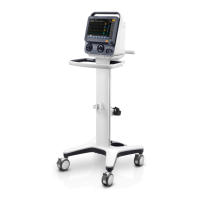B-18
PbOOPb 22
2
O
2
sensor is current generator, and the current is proportional to the rate of oxygen consumption
(Faraday's Law). This current can be measured by connecting a resistor across the output terminals
to produce a voltage signal. If the passage of oxygen into the sensor is purely diffusion limited, by
the solid membrane diffusion barrier, then this signal is a representation of the oxygen partial
pressure.
Signal Stability
O
2
sensor has highly stable outputs over their operating lives. Typical sensor drift rates are less
than 1% per month when O
2
sensor is exposed to gas in typical applications. Thus a sensor with a
starting signal of 12mV in 210mBar oxygen will typically still be showing a signal greater than
10mV as it approaches the end of its life.
Humidity Effects
Under conditions where liquid condensation may occur, care is needed to ensure the gas access
holes do not become blocked. If liquids form in the region of the gas access hole, the flow of gas
to the sensor will be restricted. With gas access restricted, a low signal will result. If a sensor
shows signs of being affected by condensation, normal operation may be restored by drying the
sensor with a soft tissue. Under no circumstances should these sensors be heated to dry them out.
Changes in humidity levels which affect the O
2
partial pressure will correspondingly alter the
output signal of the sensor.
Pressure Effects
Since the sensor measures O
2
partial pressure, the output will rise and fall due to pressure changes
which affect the O
2
partial pressure. Thus an increase in pressure of 10% at the sensor inlet will
produce a 10% increase in signal output. Nitrous oxide is highly soluble in neutral and alkaline
solutions. Where the sensor is exposed to high levels of nitrous oxide, the solubility of this gas can
in fact cause the internal pressure to increase to the point where the seals fail. O
2
sensor
incorporates a patented pressure relief system in the rear of the sensor, limiting the internal
pressure build up due to N
2
O dissolving in the electrolyte to a figure well within the capacity of
the sealing system. Test data shows that sensors are unaffected by months of operation in 100%
N
2
O. Cross-interference tests with 10% CO
2
(balance O
2
) show virtually no interference from
CO
2
.
Temperature Dependence
The rugged design of O
2
sensor means it is resistant to damage from extremes of high or low
temperature. Even so, the sensor must never be exposed to temperatures at which the electrolyte
will freeze (approx. -25°C), or temperatures which will harm the components of the sensor, i.e.
The plastic or seals (>70°C). Sensor lifetime is governed by the mass of lead available to react
with oxygen and its rate of consumption. High oxygen partial pressures and high temperatures will
increase the sensor output current, thus shortening the operating life.

